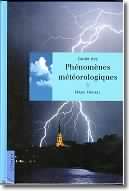|
|
|
IN
BIBLIOTECA
|
|

|
GUIDE DES PHENOMENES METEOROLOGIQUES
Hans Häckel
Editions
Ulmer, Paris, 2000
324 photographies en couleurs et 40 illustrations
336 pages
ISBN : 2-84138-131-5
|
Pourquoi le ciel est-il bleu ? Et pourquoi devient-il rouge au crépuscule ?
Pourquoi les gouttes de rosée se forment-elles sur les pointe des brins d'herbe ?
Comment lire le temps à venir dans la forme des fumées ?
En s'appuyant sur plus de 300 photographies, souvent exceptionnelles,
l'auteur nous invite à redécouvrir et comprendre ces phénomènes naturels qui nous entourent et que par
habitude, nous ne voyons plus.
Des phénomènes les plus courants (les couleurs du ciel, de l'eau, les formes des
nuages, les halos, les arcs-en-ciel, la neige, la grêle, l'orage, ....) et leurs implications pratiques (la prévision du
temps, la pollution, l'effet de serre, les microclimats,... ) aux phénomènes les plus rares (le rayon
vert, les boules de foudre, les feux de Saint-Elme, ...), ce livre nous rouvre les yeux sur la magie du
quotidien.
|
Cirrus clouds are high, thin, tropospheric clouds composed predominately of ice. In the last ten years, considerable work has shown that cirrus is widespread--more common than previously believed--and has a signigicant impact on climate and global change. As the next generation weather satellites are being designed, the impact of cirrus on remote sensing and the global energy budget must be recognized and accommodated. This book, the first to be devoted entirely to cirrus clouds, captures the state of knowledge of cirrus and serves as a practical handbook as well. Each chapter is based on an invited review talk presented at Cirrus, a meeting hosted by the Optical Society of America and co-sponsored by the American Geophysical Union and the American Meteorological Society. All aspects of cirrus clouds are covered, an approach that reaches into diverse fields. Topics include: the definition of cirrus, cirrus climatologies, nucleation, evolution and dissipation, mixed-phase thermodynamics, crystallinity, orientation mechanisms, dynamics, scattering, radiative transfer, in situ sampling, processes that produce or influence cirrus (and vice versa), contrails, and the influence of cirrus on climate.
|
|

Guida
al sito
| Contattaci
| Segnala
il sito | Credits
| Copyrights
|
|